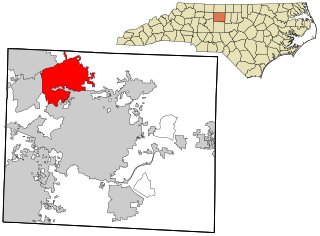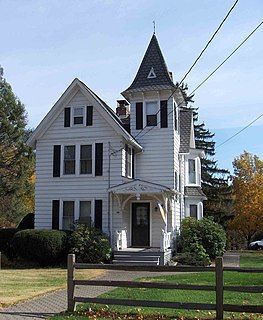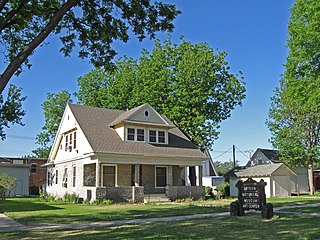
Summerfield is a town in Guilford County, North Carolina, United States. The population was 7,018 at the 2000 census. At the 2010 census, the population had risen to 10,232.

Pinnacle is an unincorporated community and census-designated place in southwestern Stokes County, North Carolina, United States, approximately 5 miles (8.0 km) SSE of the town of Pilot Mountain, between Pilot Mountain State Park and Hanging Rock State Park. As of March 2015, the exact population is 855.

This is intended to be a complete list of the properties and districts on the National Register of Historic Places in Fairfield County, Connecticut, United States. The locations of National Register properties and districts for which the latitude and longitude coordinates are included below, may be seen in an online map.

Westland Mansion was the home of Grover Cleveland, the 22nd and 24th President of the United States, from his retirement in 1897 until his death in 1908. The house is located in the historic district of Princeton, New Jersey, and is a National Historic Landmark also known as the Grover Cleveland Home.

Charles W. Van De Mark House is a Queen Anne style historic building located in Clyde, Kansas, which is listed on the National Register of Historic Places. It was listed in 1985. It was deemed notable " local architectural significance as one of the most elaborate and best preserved of the late nineteenth-century houses of Clyde."

The F.F. Tomek House, also known as The Ship House or as the Ferdinand Frederick and Emily Tomek House, is a historic house at 150 Nuttall Road in Riverside, Illinois. It is prominent example of Prairie School design by Frank Lloyd Wright. Designed in 1904 and construction finished in 1906, the Tomek House is a well-preserved example of the style. In addition to being a good example of the Prairie style, the Tomek house documents the development of the style, which reached its clearest expression in Wright's Robie House in 1908. It is included in the Riverside Historic District and was declared a National Historic Landmark in 1999.

The Cape May Historic District is an area of 380 acres (1.5 km2) with over 600 buildings in the resort town of Cape May, Cape May County, New Jersey. The city claims to be America's first seaside resort and has numerous buildings in the Late Victorian style, including the Eclectic, Stick, and Shingle styles, as well as the later Bungalow style, many with gingerbread trim. According to National Park Service architectural historian Carolyn Pitts, "Cape May has one of the largest collections of late 19th century frame buildings left in the United States... that give it a homogeneous architectural character, a kind of textbook of vernacular American building."

The South Britain Historic District in Southbury, Connecticut, United States, is a historic district that was listed on the National Register of Historic Places in 1987. It represents the central portion of South Britain, an unincorporated village. The district is bordered by the Pomperaug River on the west. Water-powered mills, supplied by water from a South Britain Water Power Company reservoir, were the impetus for early development.

Dinglewood is a neighborhood/subdistrict located at the southern edge of Midtown Columbus, Georgia. In it is the tallest building in Columbus, the Aflac Tower. It is also home to the famous Dinglewood Pharmacy, which serves, in the opinions of the city's residents, the city's best scrambled hot dog. The boundaries of the neighborhood are generally acknowledged to be 17th Street to the north, Martin Luther King, Jr. Boulevard to the south, Interstate 185 to the east and Veterans Parkway to the west. In 2007, the estimated population of the area was 1,101.

Marion is a neighborhood in the town of Southington in Hartford County, Connecticut, United States. It is generally the area in the vicinity of the intersection of Route 322 and Marion Avenue just north of the Cheshire town line.

The Carlowville Historic District is a historic district in the community of Carlowville, Alabama. The historic district covers 780 acres (320 ha) and is centered on Alabama State Route 89 and Dallas County roads 4, 47 and 417. It was placed on the National Register of Historic Places on January 18, 1978.

This is a list of the National Register of Historic Places listings in Lyon County, Minnesota. It is intended to be a complete list of the properties and districts on the National Register of Historic Places in Lyon County, Minnesota, United States. The locations of National Register properties and districts for which the latitude and longitude coordinates are included below, may be seen in an online map.

The Makens Bemont House, commonly called the Huguenot House, is a historic house museum at 307 Burnside Avenue in East Hartford, Connecticut. Built in 1761, it is one of the town's few surviving 18th-century buildings, and is one of several buildings located in Martin Park that are operated by the Historical Society of East Hartford as the Historical Houses at Martin Park. It was listed on the National Register of Historic Places in 1982.

The Town Farms Inn is a historic poor farm on Silver Street at River Road in Middletown, Connecticut. It was listed on the National Register of Historic Places in 1979. The poor farm provided employment and food for indigent people.

The Charles F. and Ruth Chase House, also known as the Judge Whitmore House, is a historic residence located in Atlantic, Iowa, United States. Charles and Ruth Chase established a local newspaper, the Atlantic News-Telegraph. Their son, Edwin Percy Chase, joined his father in the business and won the Pulitzer Prize for the best editorial of 1933. Ruth Chase bought the property the house was built on in 1914 from Dr. F. W. Porterfield for $2,500. The Porterfield house was torn down and this home was completed the following year. It was designed by Creston, Iowa architect Clarence Yule, and is based upon the architectural style made famous by the architect Frank Lloyd Wright. The two-story, stucco-on-frame, Prairie School dwelling features a hipped roof, enclosed front porch, wide overhanging eaves, ribbons of casement windows on both floors of the front and back elevations, and a full basement. It was listed on the National Register of Historic Places in 1999.

The Dr. G.S. Martin House is a historic residence located in Maquoketa, Iowa, United States. It is a fine example of houses built in town for the professional class during Maquoketa's economic expansion in the late 19th century. It presents a more subdued and conservative appearance than other local Italianate homes. Built in 1882, the two-story brick house features a limestone foundation, a dressed stone water table, a low pitched hip roof, projecting low pitched gable wings, and simple brackets under the broad eaves. There are two porches on the house. The front porch is capped with iron cresting. Dr. Martin was one of the first physicians in town when he settled in here in 1857. He also worked as a druggist. The house was listed on the National Register of Historic Places in 1991.

The Timothy Davis House is a historic building located at 405 First Street NW in Elkader, Iowa.

The Dr. Martin H. Caulkins House and Office is a historic building located in Wyoming, Iowa, United States. Caulkins was a New York native who started out as a teacher before studying medicine. He married his wife Lucinda Louden in 1855, and moved to Iowa the following year. Caulkins was the first physician to serve this rural community. He also served as the town's first mayor, and in the Iowa Legislature. The two-story, frame house was built in two parts. The success of his practice allowed him to build this house starting in 1860, and he continued to add to it as the need and finances allowed. Caulkins maintained his office in his house. It is a two-story frame structure that adheres to no particular style. The house was listed on the National Register of Historic Places in 1979.

The Miller-Martin Town House is a historic house in Clayton, Alabama, U.S.. It was built as a townhouse for John H. Miller in 1859, and it was designed in the Gothic Revival architectural style. In 1871, it was purchased by Judge Henry Clinton Russell, who served on Barbour County's probate court. In 1915, it was purchased by John Council Martin, who went on to serve as the mayor of Clayton from 1926 to 1930. It was later inherited by his daughter. It has been listed on the National Register of Historic Places since December 16, 1974.

The Moore-Ward Cobblestone House, at 505 W. Richardson Ave. in Artesia, New Mexico, was built in 1905. It was listed on the National Register of Historic Places in 1984.























